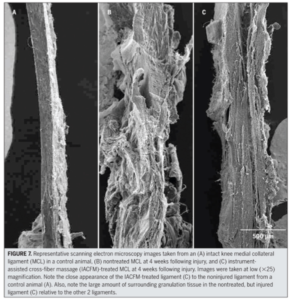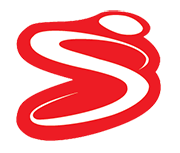Instrument Assisted Soft Tissue Mobilization (IASTM) is a form of soft tissue manipulation that utilizes a tool to improve tissue mobility and stimulate your bodies innate healing mechanisms. The instruments consist of convex and concave curves that mold to the contours of the body and offer either a gentler or more aggressive soft tissue release, depending on their shape and the practitioners desired effect. The shapes allow for the treatment of any region of the body, from the small contours of the hand to the larger muscle groups like the hamstring. Commonly known approaches that utilize Instrument Assisted Soft Tissue Mobilization include “Graston” and “AYSTM“ techniques. (Click here to read an article from ‘Trail Runner’ magazine on ASTYM technique)
When these instruments are run along the surface of a muscle or tendon, the therapist (and patient) can appreciate occasional vibrations where the instruments ‘catch’ on irregular fibrosis 1 (commonly, if not totally accurately, referred to as ‘scar tissue’) within the muscle, fascia or tendon. This abnormal tissue (disorganized and/or fibrosed) can result from repetitive strain, trauma, surgery and immobilization.
Treatment with these specialized instruments is thought to break up adhesions in fibrosed tissue, particularly within the various interfaces between the planes of muscles, nerves, fascia, etc., can become adhered and restricted. 2
Improving the ‘glide’ between tissue layers and breaking up adhesions within the various tissues can improve the mobility of muscle, tendon and fascia. 3 4 5
Our patients routinely report an immediate sensation of improved mobility with treatment.
Diagnostic ultrasound has shown, as an example, in a study of patients with chronic low-back pain, demonstrated a lack of gliding and sliding of the dense fibrous connective tissue overlying the lumbar spine known as the Thoraco-Lumbar fascia. Patients with pain demonstrated ~ 20% less mobility as compared to the control group (without low back pain) 6

IASTM can also be used to promote the ‘remodeling’ and/or activate the ‘regeneration’ of abnormal soft tissues (muscle, tendon, etc) through a process referred to as ‘Capillary Leakage’. It is hypothesized that mechanically induced leakage from local capillaries can “lead to fibroblast activation, phagocytosis, and the release of growth factors” 7 8 9 to jump start the bodies natural healing processes.
Whatever the mechanism, IASTM has been shown to accelerate healing time frames for both tendon and ligament injuries 10 11 and result in improved biomechanical properties in treated tissues. Researchers found that torn knee MCL (ligament) treated with IASTM intermittently during the healing /recovery phase, resulted in a 43% stronger ligament 4 weeks out from injury! 12
Research describes the usefulness of IASTM in treating a multitude of injuries including Patellofemoral Pain, 13 14 Plantar Fasciitis, 15 16 Ankle Pain, 17 18 Calf Pain, 19 Shin Splints, 20 Achilles Teninopathy, 21 22 23 Hamstring Tendinopathy, 24 Wrist Tendonitis, 25 Elbow Tendonitis, 26 27 and Carpal Tunnel. 28
IASTM is most effective when used in conjunction with other therapeutic interventions (progressive loading with exercise, mobility drills, etc.). All of our Physical Therapists have undergone training specific to the use of Instrumented Soft Tissue Mobilization.
If you have a stubborn soft tissue injury make an appointment today and see how this treatment approach can enable a more rapid return to activity, free from pain and limitation.

